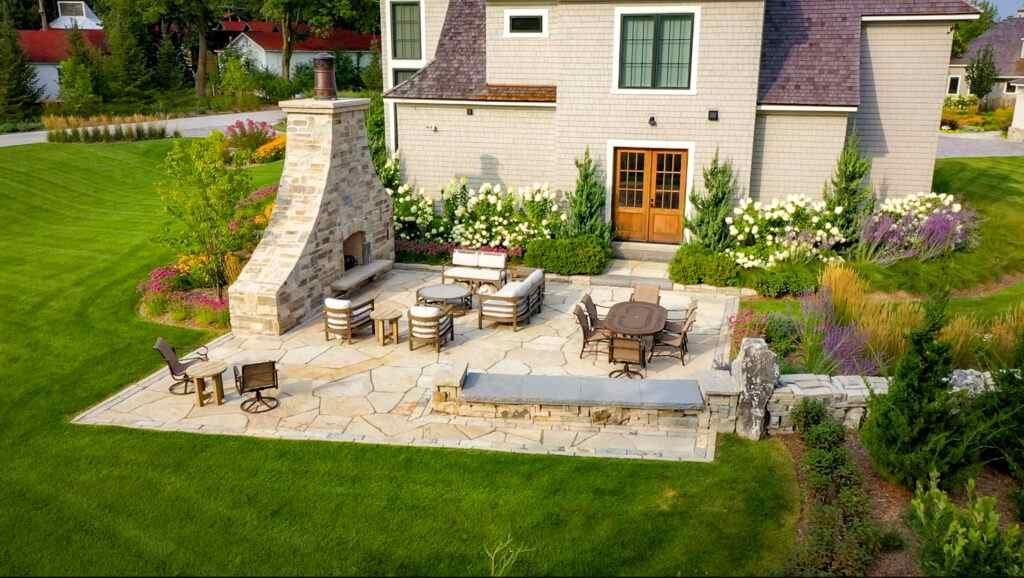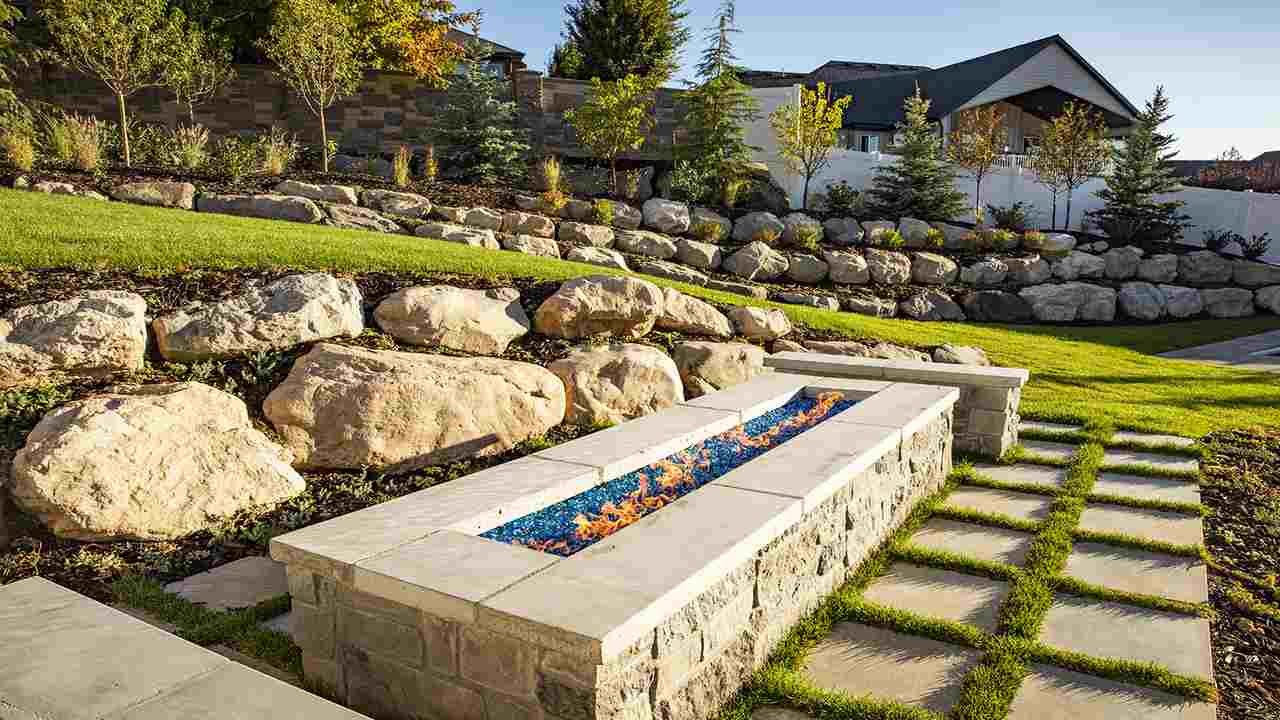When it comes to hardscaping, Evergreen Landscaping of Cincinnati knows their stuff! They work with a range of materials to create stunning outdoor spaces. Concrete is a popular choice for its durability and versatility, ideal for patios and walkways. Brick adds a timeless charm, perfect for retaining walls and edging. Natural stone like granite or limestone brings a touch of elegance to any design. Wood, though not as durable, lends warmth and character to decks and pergolas. Finally, metals like steel or aluminum offer a modern flair, great for accents and structural elements.
Hardscaping is all about creating beautiful, functional outdoor spaces using durable materials that can withstand the elements. From patios to retaining walls, there’s a wide array of materials commonly used in hardscaping projects. Let’s dive into some of the most popular choices and explore their unique qualities.
Concrete
Concrete is a staple in hardscaping due to its durability, versatility, and affordability. It can be poured into various shapes and sizes, making it ideal for patios, driveways, walkways, and even decorative features like steps and benches. One of the advantages of concrete is its ability to mimic other materials such as stone or brick through stamping and coloring techniques. This allows for creative designs while maintaining a robust structure that can withstand heavy foot traffic and weather conditions.
Brick
Brick is a versatile material that extends beyond traditional uses, such as for driveways and walkways. Professional hardscaping services often utilize brick for creating durable and visually appealing driveways and walkways. Brick’s strength and aesthetic appeal make it ideal for enhancing curb appeal and adding character to outdoor spaces. Whether used in intricate patterns or simple designs, brick driveways and walkways offer a timeless charm and functional durability that homeowners appreciate in their landscapes.
Brick brings a timeless charm to hardscape designs. Made from clay that’s fired in a kiln, bricks come in a range of colors and textures, offering endless possibilities for creating intricate patterns and borders. They are commonly used for building retaining walls, edging flower beds, and constructing pathways. Brick’s durability and low maintenance make it a popular choice for both residential and commercial hardscaping projects.
Natural Stone

Natural stone, including materials like granite, limestone, slate, and flagstone, adds a touch of elegance and natural beauty to outdoor spaces. Each type of stone has its unique characteristics, from the rugged texture of slate to the smooth finish of granite. Natural stone is often used for creating stunning patios, fire pits, seating walls, and water features. Its durability and resistance to weather make it a long-lasting option that ages beautifully over time.
Wood
Wooden elements bring warmth and a rustic appeal to hardscape designs. Common types of wood used in hardscaping include cedar, redwood, and pressure-treated lumber. Wood is often used for building decks, pergolas, fences, and privacy screens. It creates a cozy atmosphere and can be stained or painted to match the overall aesthetic of the outdoor space. While wood requires regular maintenance such as sealing and staining to prevent rot and weathering, many homeowners appreciate its natural charm.
Composite Materials
Composite materials in hardscaping services encompass a range of options like composite decking, railing systems, and structural elements. These materials offer durability, low maintenance, and aesthetic appeal, making them popular choices for outdoor living spaces. Hardscaping services that incorporate composite materials provide clients with versatile solutions that withstand weather conditions and provide long-lasting beauty to decks, patios, walkways, and other hardscape features.
Composite materials combine the best of both worlds by blending natural fibers with synthetic polymers. These materials, such as composite decking and railing systems, offer the look of wood without the maintenance challenges. They are resistant to rot, insects, and fading, making them an attractive option for outdoor living areas. Composite materials come in various colors and finishes, allowing for customization to suit different hardscaping styles.
Metal
Metal elements can add a modern and industrial touch to hardscape designs. Common metals used include steel, aluminum, and wrought iron. Metal is often incorporated into structures like pergolas, arbors, railings, and decorative accents. It provides strength and durability while lending a contemporary aesthetic to outdoor spaces. Metal can be painted or powder-coated to enhance its appearance and protect it from corrosion.
Pavers
Pavers play a crucial role in Liberty Township hardscaping projects, especially in designing for accessibility. Professional hardscaping services in the area utilize pavers to create accessible pathways, ramps, and outdoor spaces that comply with ADA (Americans with Disabilities Act) guidelines. Pavers offer a durable, slip-resistant surface that enhances mobility for individuals with disabilities while maintaining aesthetic appeal. Incorporating pavers into hardscape designs ensures that outdoor areas in Liberty Township are not only beautiful but also inclusive and accessible to all.
Pavers are pre-cast concrete, stone, or clay units used for creating durable and visually appealing surfaces. They come in various shapes, sizes, colors, and textures, allowing for endless design possibilities. Pavers are commonly used for driveways, walkways, patios, and pool decks. They offer a non-slip surface, easy installation, and the ability to withstand heavy loads. Additionally, pavers can be arranged in patterns like herringbone, basket weave, or running bond to create unique visual effects.
Gravel and Crushed Stone
Gravel and crushed stone are versatile materials used in hardscaping for pathways, driveways, and decorative accents. Gravel comes in different sizes and colors, providing options to match the overall design theme. It allows for good drainage and is relatively low maintenance. Crushed stone, often used as a base material for patios and walkways, provides a stable foundation and can be compacted for added durability.
Boulders and Rocks

Boulders and rocks are natural elements that add a rugged and organic look to hardscape designs. They are used for creating retaining walls, bordering plant beds, and enhancing naturalistic landscapes. Boulders come in various sizes and shapes, ranging from small decorative rocks to massive stones that serve as focal points in garden settings. Their natural colors and textures blend seamlessly with surrounding vegetation, creating a harmonious outdoor environment.
Synthetic Turf
Synthetic turf is a key component of landscaping renovation services, offering low-maintenance alternatives to natural grass. Landscaping renovations often involve replacing traditional lawns with synthetic turf, which requires no watering, mowing, or fertilizing. This eco-friendly solution is durable, safe for children and pets, and maintains its lush appearance year-round. Incorporating synthetic turf into landscaping renovations enhances outdoor spaces, reduces water usage, and provides homeowners with a vibrant, hassle-free lawn solution.
Synthetic turf, also known as artificial grass, is gaining popularity in hardscaping projects, especially for areas where natural grass is challenging to maintain. Synthetic turf offers a lush green appearance year-round without the need for watering, mowing, or fertilizing. It’s pet-friendly, durable, and provides a soft surface for recreational activities. Synthetic turf can be installed on rooftops, balconies, play areas, and other outdoor spaces to create inviting and low-maintenance landscapes.
In summary, hardscaping materials vary in terms of appearance, durability, maintenance requirements, and cost. Choosing the right materials for your hardscape project depends on factors such as the desired aesthetic, functionality, climate, budget, and maintenance preferences. Consulting with a professional landscaper or hardscape designer, like Evergreen Landscaping of Cincinnati, can help you make informed decisions and create a stunning outdoor space that suits your needs and enhances your property’s beauty and functionality.
FAQs
What materials are used for hardscape?
Materials commonly used for hardscaping include concrete, brick, natural stone (like granite or limestone), wood, composite materials (such as composite decking and railing systems), metal (like steel or aluminum), pavers, gravel, boulders, rocks, and synthetic turf. Each material offers unique characteristics in terms of durability, aesthetics, and functionality, allowing for diverse hardscape designs that cater to different preferences and needs. Professional hardscape designers often combine these materials creatively to create stunning outdoor spaces.
What are hard-scape materials?
Hardscape materials refer to non-living elements used in landscaping and outdoor design, such as concrete, brick, stone, wood, metal, pavers, and synthetic materials. These materials are used to create structural features like patios, walkways, retaining walls, decks, and other permanent fixtures in outdoor spaces. Hardscape materials are chosen for their durability, functionality, and aesthetic appeal, enhancing the overall look and usability of outdoor environments.
What is the best material to use for landscaping?
The best material for landscaping depends on factors such as climate, budget, maintenance preferences, and the desired aesthetic. Natural stone, like granite or limestone, is often favored for its durability and timeless beauty, suitable for various hardscape features. However, other materials like composite decking, which offer low maintenance and customizable options, can also be excellent choices depending on the specific needs of the project.
Which is an example of a hardscape?
A patio made of concrete or natural stone is a classic example of a hardscape. It provides a solid, durable surface for outdoor seating, dining, and entertainment areas. Additionally, hardscape features like retaining walls or pathways made of brick or pavers are also common examples in landscaping.
What is the cheapest hardscaping?
Gravel is often considered one of the cheapest hardscaping materials due to its affordability and easy installation. It can be used for pathways, driveways, and decorative areas, offering good drainage and a textured appearance. However, the overall cost of a hardscaping project depends on factors like the size of the area, labor costs, and any additional materials or features included.
Conclusion
In conclusion, hardscaping offers a plethora of materials to choose from, each contributing unique aesthetics and functionality to outdoor spaces. Concrete, brick, natural stone, wood, composite materials, metal, pavers, gravel, boulders, rocks, and synthetic turf all play vital roles in creating durable, visually appealing, and functional hardscape designs.
The selection of hardscaping materials depends on various factors such as the desired look, budget, climate, maintenance requirements, and intended use of the outdoor space. Professional landscapers and hardscape designers, like Evergreen Landscaping of Cincinnati, can provide valuable expertise and guidance in selecting the right materials and creating cohesive hardscape designs that enhance the overall beauty and functionality of residential and commercial properties.
Whether it’s creating inviting patios, durable driveways, charming pathways, or captivating water features, the combination of well-chosen hardscaping materials and thoughtful design can transform outdoor areas into stunning retreats that homeowners can enjoy for years to come.
